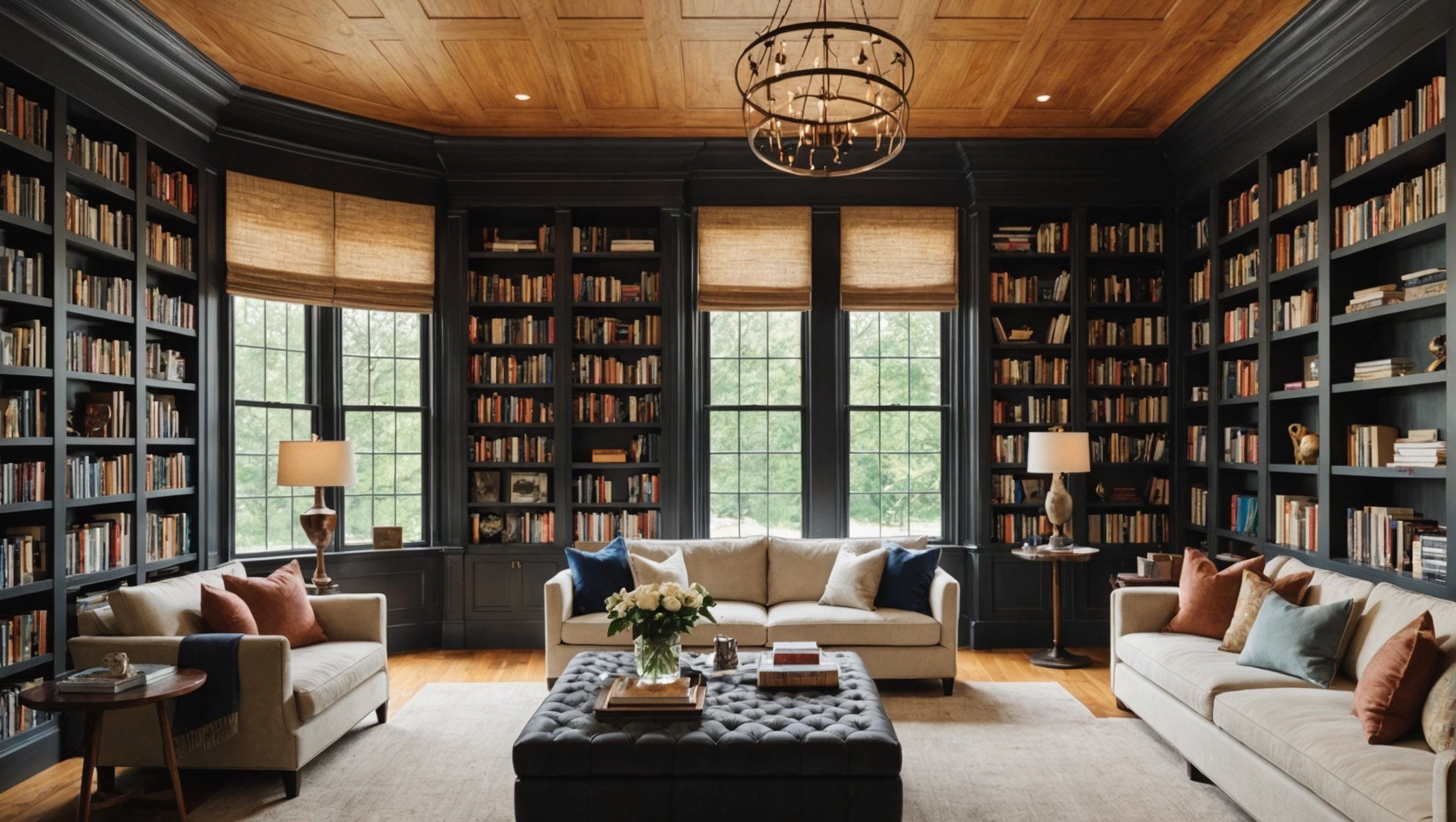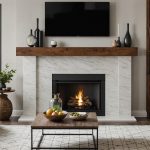Importance of Natural Light in Home Libraries
Incorporating natural light benefits into your home library design can significantly enhance your reading experience. Optimal light conditions not only promote better focus but also create a pleasant ambiance. The psychological impact of sunlight is substantial, improving both mood and productivity. Natural light is known to reduce eye strain, which is essential for prolonged reading or studying sessions. This can elevate overall comfort while enjoying a good book.
Moreover, designing a space that considers the ambiance enhancement brought by sunlight can foster a conducive environment for relaxation. Sunlight has been linked to the release of serotonin in the brain, a hormone that positively affects mood and relaxation. When strategically planned, a well-lit library can become a sanctuary for not just reading, but also unwinding.
Also to read : Creating a Cozy and Secure Fireplace Sanctuary for Your Family Home: Expert Design Tips
It’s also crucial to consider window placements when planning your home library design. Natural light benefits, such as improved alertness and reduced fatigue, can be maximised by allowing enough daylight to filter in. Thoughtful furniture arrangement can further enhance these benefits, ensuring your space is both functional and inviting. Adjusting for glare with curtains or blinds, if needed, can strike the perfect balance, ensuring a perfect blend of utility and comfort.
Architectural Styles for Sunlit Libraries
Incorporating sunlit spaces within a home library can significantly enhance the ambiance and functionality. While traditional styles like Victorian and Colonial architectures have their own charm, blending these with modern design can create a truly inviting environment.
This might interest you : Eco-Friendly Bathroom Design: Your Ultimate Guide to Water and Energy Conservation
Traditional Architectural Features
Traditional home library architectures often include ornate woodwork and intricate detailing. Victorian styles might showcase stained glass and high ceilings, while Colonial designs could feature symmetry and large, framed windows. These elements, when combined with natural light, create a warm, timeless space that encourages leisurely reading.
Modern Design Elements
In contrast, modern design styles focus on simplicity and minimalistic elements. Incorporating large windows and broad skylights positively transforms these spaces into sunlit retreats. The use of sleek materials, such as glass and metal, complements this style, enhancing the sense of openness and tranquillity.
Open Concept Integration
Open concept designs are ideal for enhancing the flow of natural light throughout the home library. They integrate open floor plans with expansive doorways and minimal barriers. This approach not only maximizes sunlight but also creates a sense of cohesion with the rest of the home, promoting a seamless blend of indoor and outdoor living.
Layout Considerations for Maximizing Natural Light
Creating an inviting library layout involves strategic planning to harness natural light, enhancing both the ambiance and functionality of the space. One of the most effective approaches is to carefully consider room orientation. Placing rooms on the southern or south-western side of a building can capture the maximum amount of daylight throughout the day.
Furthermore, space planning should prioritize light circulation. By arranging furniture such as bookshelves and seating areas to avoid blocking windows, you allow light to flow more freely. Choose lower profile furniture to prevent unwanted shadows and create a more open feel.
To foster a comfortable and welcoming environment, think about designing cozy reading nooks. Position these spaces close to windows to maximise natural light access. Including comfortable seating and adequate shelving in these nooks can make them ideal spots for relaxation or study. Thoughtful space planning also ensures that such areas remain uncluttered, further enhancing the natural brightness.
By combining strategic space planning with thoughtful room orientation, you can transform a library into a haven of light and calm, promoting both reading pleasure and wellbeing.
Color Schemes that Enhance Light
Creating a visually appealing home library involves more than just bookshelves and reading nooks. Thoughtful color psychology can transform your space into a haven of light and inspiration.
Light Colors and Their Effects
Light-reflective colors play a crucial role in illuminating spaces. Whites, soft blues, and pale yellows can make a room feel larger and more inviting. These hues reflect natural light, giving the space an airy, open feel. By applying these shades on walls or ceilings, you’ll notice an improvement in how light is distributed, significantly enhancing your home library aesthetics.
Accent Colors for Contrast
To ensure your library doesn’t feel washed out, consider using accent colors. Deep greens, rich browns, or even bold reds can provide contrast, drawing attention to particular elements without overwhelming the senses.
Textures that Complement Light
Textures bolster the room’s visual appeal. Gain warmth and depth by selecting materials like velvet, which absorb light and add a soft contrast to light-reflective colors. Additionally, finishes such as satin or semi-gloss paints can work magic in amplifying light. Consider these suggestions as a guide to create a space that’s both functional and aesthetically pleasing.
Innovative Window Placements and Treatments
Enhancing natural light in a space can significantly impact its ambience and energy efficiency. Window design plays a pivotal role, with certain styles proving more effective. For instance, casement windows are hinged on the side and open outward, allowing maximum air flow and light. Meanwhile, bay windows, projecting from the building’s façade, create spacious alcoves that gather light from various angles.
Window placement is critical to optimising sunlight. Understanding sun paths throughout the day can guide the positioning for optimal light intake. For example, south-facing windows are perfect for harnessing warmth in colder climates, whereas north-facing ones provide consistent natural light without much direct glare. East-facing windows capture morning light, ideal for spaces like kitchens and bedrooms, while west-facing ones offer warm, evening light, perfect for living areas.
When it comes to treatment ideas, options such as sheer curtains or blinds maintain a balance between privacy and light. Frosted or textured glass can also allow light to flood while ensuring privacy. Other alternatives include adjustable blinds or smart glass technology, which can adapt to changing light conditions throughout the day. Exploring these options ensures a harmonious blend of privacy and illumination.
Integrating Artificial Lighting with Natural Light
Creating a cohesive ambiance in a home library involves seamlessly merging artificial lighting with natural light. By doing so, you significantly enhance the room’s functionality and aesthetic appeal.
Types of Lighting Fixtures
Choosing the right lighting solutions is crucial. For layered lighting, consider incorporating:
- Ambient lighting: Provides overall illumination. Options include ceiling-mounted fixtures or wall sconces.
- Task lighting: Essential for reading or detailed work, typically in the form of desk lamps or adjustable floor lamps.
- Accent lighting: Highlights specific objects or architectural features, often delivered through spotlights or under-shelf lights.
Layering Techniques for Balance
Layered lighting effectively marries natural light with artificial sources, maintaining a balance throughout the day. Start by assessing where natural light enters the room and layer additional light sources to fill in areas that remain dark. Use dimmers to adjust light intensity, ensuring both utilitarian and atmospheric needs are met.
Smart Lighting Solutions
Smart lighting offers flexibility and energy efficiency by automatically adapting to natural light levels. Systems like Philips Hue allow for controlled lighting adjustments via mobile devices, enhancing the home library ambiance. These solutions provide a dynamic balance between ambient, task, and accent lights, creating a tailored space where reading and relaxation blend effortlessly.
Selecting Materials That Complement Natural Light
When it comes to choosing building materials for a well-lit space, both aesthetic considerations and sustainability should be at the forefront. Natural materials like wood and glass play a significant role in enhancing the ambiance. Wood, with its warm tones, can add a cozy feel, while glass allows light to flow freely, creating an open and airy environment.
Sustainability Considerations
Choosing materials with sustainability in mind not only benefits the environment but also adds long-term value to your project. Sustainable choices often include reclaimed or responsibly sourced wood, which reduces the carbon footprint. Glass, which is recyclable, offers a contemporary look and maximises natural light efficiency.
Material Choices and Light Perception
The materials you select significantly impact how light is perceived in a space. For instance, glossy finishes on walls and surfaces can reflect more light, making a room appear brighter. Conversely, matte finishes absorb light, creating a softer, more subdued atmosphere. Combining different textures can strike a balance, complementing the natural light in ways that enhance or soften its effect, depending on the desired ambiance.
Making informed choices in selecting building materials can lead to a harmonious blend of aesthetics, sustainability, and efficient light utilisation, transforming your space into a welcoming haven.
Creating a Cozy Reading Environment
Designing a comfortable reading nook involves intentional choices that cater to comfort and aesthetic appeal. One primary consideration is selecting the right furniture choices for comfort. Opt for ergonomic seating that supports extended reading sessions without causing discomfort. Chairs with adjustable backrests and arm support enhance reading comfort significantly.
Furniture Choices for Comfort
The foundation of a cozy reading space begins with furniture. Ergonomically designed chairs or cushioned window seats are ideal. They offer essential back support and help maintain posture during lengthy reads. Consider pairing seating with small side tables for convenience.
Ideal Decor Elements
To elevate the coziness factor, focus on decor. Softer lighting, such as floor or table lamps with adjustable settings, creates a soothing atmosphere. Shelves that showcase your books and library accessories, such as bookends or unique storage solutions, add character while being functional.
Personal Touches to Enhance Ambiance
Adding personal touches, such as wall art or cherished items, inject warmth into the environment. Accessories like soft blankets, plush pillows, and even a well-placed rug can transform a mundane space into a cozy design masterpiece. Opt for textures and materials that appeal to your senses, ensuring your reading environment becomes a personal sanctuary.











